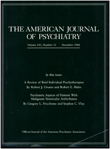The dexamethasone suppression test in the clinical setting
Abstract
The authors administered the dexamethasone suppression test (DST) to 47 inpatients on a clinical, nonresearch psychiatric unit who had been diagnosed according to DSM-III. Of the 30 patients with major depression, 23 (77%) exhibited nonsuppression (serum cortisol concentrations greater than 5 micrograms/dl); only 1 of the 17 patients with other diagnoses and depressive symptoms exhibited nonsuppression. There was no difference in the rate of nonsuppression between the patients with subgroups of major depression, but those with major depression and psychosis had significantly higher postdexamethasone cortisol levels than those with major depression with and without melancholia and those with diagnoses other than major depression.
Access content
To read the fulltext, please use one of the options below to sign in or purchase access.- Personal login
- Institutional Login
- Sign in via OpenAthens
- Register for access
-
Please login/register if you wish to pair your device and check access availability.
Not a subscriber?
PsychiatryOnline subscription options offer access to the DSM-5 library, books, journals, CME, and patient resources. This all-in-one virtual library provides psychiatrists and mental health professionals with key resources for diagnosis, treatment, research, and professional development.
Need more help? PsychiatryOnline Customer Service may be reached by emailing [email protected] or by calling 800-368-5777 (in the U.S.) or 703-907-7322 (outside the U.S.).



